

|
|
As an Affiliated Program of SCOR, the IOCCG Committee is required to implement a regular rotation of scientific committee members. Accordingly, a number of scientific committee members rotated off the Committee after the 18th IOCCG Committee meeting including Steven Greb, Joji Ishizaka, Dmitry Pozdnyakov and Tasuku Tanaka. They were replaced by Heidi Dierssen (USA), Takafumi Hirata (Japan), Young-Je Park (Korea) and Andrew Tyler (UK). In addition, Joo-Hyung Ryu (KIOST, Korea) will be replacing Yu-Hwan Ahn on the IOCCG Executive Committee as the official representative of the Korea Institute of Ocean Science and Technology (KIOST). We thank the retiring members for their hard work and contributions over the past few years and extend a warm welcome to our new Committee members. .  New IOCCG Committee members Heidi Dierssen, Young-Je Park, Andrew Tyler and Takafumi Hirata. The full minutes of the 18th IOCCG Committee meeting are now available on the IOCCG website at www.ioccg.org/reports/Minutes-18.pdf.
The first International Ocean Colour Science meeting (IOCS) will take place in Darmstadt, Germany from 6 - 8 May 2013. Over 280 participants from 36 different countries have registered for the meeting. Five distinguished research scientists will provide keynote addresses including Steve Ackleson (Consortium for Ocean Leadership, USA), Shailesh Nayak (Ministry of Earth Sciences, Govt. of India), Frédéric Mélin (E.C. Joint Research Centre), Stewart Bernard (CSIR, South Africa) and Charles McClain (NASA Goddard). In addition there will be 12 splinter sessions chaired by prominent ocean colour scientists addressing a wide range of topical issues. Further details on all the splinter sessions can be found on the meeting website. These splinter sessions will provide an opportunity for extended dialogue and exchange of ideas about a specific topic, and will be open to all participants. In addition, 148 abstract have been received from ocean colour research scientists, to be discussed during the poster presentation sessions. The book of abstracts (40 MB) is available for download from the meeting website. The full meeting program can be viewed here.
VIIRS ocean colour EDR (Environmental Data Records) from NOAA operational ocean colour data processing has been declared as "Beta status" in January of 2013. Thus, VIIRS operational ocean colour EDR, which includes normalized water-leaving radiance spectra at VIIRS five spectral bands (at nominal center wavelengths of 410, 443, 486, 551, and 671 nm), chlorophyll-a concentration, and inherent optical properties (IOPs) of absorption and backscattering coefficients at VIIRS five spectral bands, are available to the public through the NOAA Comprehensive Large Array-data Stewardship System (CLASS). It is noted that VIIRS IOP data are considered as experimental products. The Beta status covers VIIRS ocean colour EDR from February 6, 2012 to present. Data quality before February 6, 2012 is very poor due to instrument calibration issue. Currently, the NOAA team has been working to include vicarious calibration gains derived with the MOBY in situ data for the VIIRS operational ocean colour data processing. As shown in the figure below, by including vicarious gains, VIIRS ocean colour EDR (e.g., chlorophyll-a concentration) will be significantly improved.
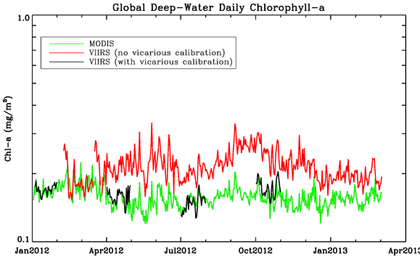 Global daily deep-water mean Chl-a concentration derived from MODIS-Aqua, NASA/OBPG (green), VIIRS with no vicarious calibration from CLASS (red), and VIIRS with vicarious calibration, generated by the NOAA ocean colour team for four months January, April, July, and October, 2012 (black).
A partial reprocessing of the MODIS-Aqua ocean colour products to incorporate updated instrument calibration was completed on 28 February 2013. All standard and evaluation MODIS-Aqua ocean colour products from 2011-2013 period and currently distributed through the NASA Ocean Color Web have been regenerated. The effect of this change is modest: largest in the 412-nm band, with much smaller impacts to other bands. Details are available here.
Profiling floats and gliders equipped with biogeochemical sensors are a rapidly evolving technology that enables observations throughout the global ocean in synergy with the Argo Program. At the 14th Argo Steering Team meeting (Wellington, New Zealand, 19-21, March 2013) Hervé Claustre (LOV, France), gave a presentation on the observational Bio-Argo float-based projects, focusing on community coordination, data management and plans for future deployment. The three primary bio-optical variables being considered for all Bio-Argo floats include Chl-a concentration, (back-) scattering coefficient and nitrate concentration, in addition to oxygen which is already embedded in the Argo system. Other variables, such as pH and radiometry, are progressively reaching a sufficient degree of readiness, turning them into possible candidates for the near future. Key oceanic areas have been identified where most of the Bio-Argo observational efforts should be conducted, as an initial step before embarking on global observations through a large Bio-Argo network. These regional “hotspots” include the Austral Ocean, the North Atlantic sub-polar gyre and the oxygen minimum zones. To date, eleven countries are engaged in the development of the Bio-Argo array, supporting float acquisition and deployment. A session entitled “Towards a Global Ocean Biogeochemical Observing System Based on Profiling Floats and Gliders” has been submitted for the next Ocean Science meeting (February 2014, Hawaii). In addition, a SCOR Working Group on "Quality Control Procedures for Oxygen and Other Biogeochemical Sensors on Floats and Gliders" was recently accepted.
Several new positions have been added to the Employment Opportunities section of the IOCCG website including two post-doctoral research positions (University Maryland/NOAA-NESDIS and Federal University Rio Grande, Brazil) plus a project manager position for Boussole. See details on the IOCCG website at www.ioccg.org/employment.html.
|
ESA and EUMETSAT have successfully concluded the first selection of 80 proposals for the Sentinel-3 Validation Team (S3VT). The first meeting of the S3VT (an open meeting) will be held at ESA ESRIN from 26 to 29th November 2013. The S3VT call has been initiated "To engage world-class validation expertise and activities to complement Sentinel-3 routine validation activities and ensure the best possible outcomes for the Sentinel-3 Mission". The call remains open to interested groups and individuals worldwide and is being implemented as a rolling call with distinct deadlines for proposal submissions on a regular basis. The next review will take place in late 2013. See earth.esa.int/aos/S3VT for full details. For more information contact Craig.donlon@esa.int and Philippe.goryl@esa.int.
The software tool WASI has been included in the IOCCG Software for Ocean Colour Data collection, and is suited to simulate and analyze optical spectral measurements from instruments deployed above and below the water surface. It includes a number of analytic models from the literature for deep and shallow waters, for example downwelling irradiance, upwelling radiance, irradiance reflectance and remote sensing reflectance. WASI is designed as a user-friendly, sensor-independent spectrum generator and spectrum analyzer with well documented calculation steps and automatic result visualization. It can be downloaded as a ZIP file (6.5 MB) from the IOCCG website.
Many new and interesting publications have been added to the IOCCG Recent References list, including a paper by ZhongPing Lee et al. (Applied Optics, 52(8), 2013) which outlines a new "Robust approach to directly measuring water-leaving radiance in the field". Accurate measurement of water-leaving radiance (Lw) in the field is a key requirement for studies of ocean optics and ocean colour remote sensing. This paper presents a new methodology, called the skylight-blocked approach (SBA), to measure Lw directly in the field, along with results obtained recently in the Laurentian Great Lakes. This method avoids some of the difficult, and inherent, data processing issues of the traditional above- and below-surface measurement schemes, and can achieve high precision measurements from oligotrophic oceanic waters to coastal turbid waters. . 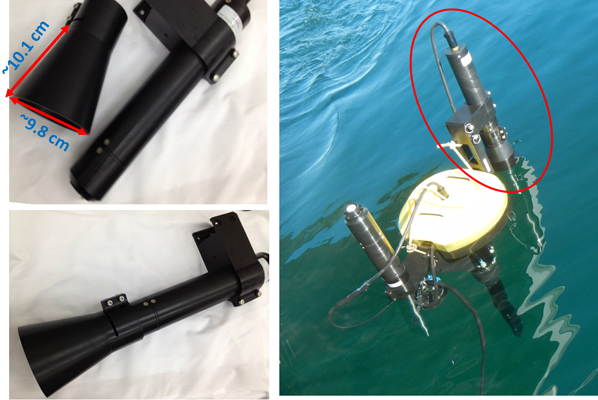 Black cone and radiometer for the skylight blocked approach (SBA) system.
Jeremy Werdell et al. (Applied Optics, 52(10), 2013) describe a "Generalized ocean color inversion model for retrieving marine inherent optical properties". Semi-analytical algorithms (SAAs) provide one mechanism for inverting satellite ocean colour measurements into inherent optical properties (IOPs). While numerous SAAs exist, most are similarly constructed and few are appropriately parameterized for all water masses for all seasons. To initiate community-wide discussion of these limitations, NASA organized two workshops that deconstructed SAAs to identify similarities and uniqueness, and to progress toward consensus on a unified SAA. This effort resulted in the development of the generalized IOP ("GIOP") model software that allows for the construction of different SAAs at runtime by selection from an assortment of model parameterizations. As such, GIOP permits isolation and evaluation of specific modeling assumptions, construction of SAAs, development of regionally-tuned SAAs, and execution of ensemble inversion modeling. Working groups associated with the workshops proposed a preliminary default configuration for GIOP (GIOP-DC), with alternative model parameterizations and features defined for subsequent evaluation. In this paper, the authors describe the theoretical basis of GIOP and present GIOP-DC and verify its comparable performance to other popular SAAs using both in situ and synthetic data sets. They also quantify the sensitivities of their output to their parameterization and use the latter to develop a hierarchical sensitivity of SAAs to various model parameterizations, to identify components of SAAs that merit focus in future research. . 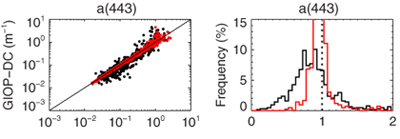 An example of comparison of GIOP-DC and in situ absorption at 443nm from NOMAD (black) and the IOCCG data set (red).
In another new publication by Severine Alvain et al. (Remote Sens. Environ. 132, 2013) the authors examine "Rapid climatic driven shifts of diatoms at high latitudes". The response of marine ecosystems to climate variability, in terms of changes in phytoplankton composition, is difficult to assess at the global scale because of the absence of large-scale in situ biological monitoring programs. In this paper, the authors combine and analyse remote-sensing observations along with in situ observations, and a global ocean biogeochemistry model to gain insight into the links between marine ecosystem composition and climate variability in the North Atlantic and Southern Ocean over the period 1998 - 2008. Significant changes in the frequency of diatom dominance were detected concurrently in all three data sources. The frequency of diatom dominance increases when the NAO and SAM climate indices are in a positive extreme. Model outputs indicate that this increase is driven by nutrient supply from deep waters during windier and more turbulent climate conditions. Such shifts in phytoplankton composition have the potential to affect various biogeochemical cycles e.g. the export of carbon to the deep ocean and dimethyl-sulfide production at the global scale.
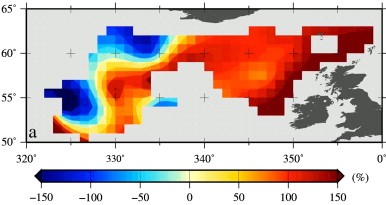 Difference (%) between monthly mean diatom frequency anomalies during positive and negative extreme of NAO index in the North Atlantic region.
Lastly, in a collaboration between NOAA Center for Satellite Applications and Research (STAR) and the Korea Institute of Ocean Science and Technology (KIOST), Menghua Wang et al. (Opt. Express 21, 2013) have been working on improving the Korean Geostationary Ocean Colour Imager (GOCI) ocean colour products, e.g., normalized water-leaving radiance spectra (nLw(λ)), chlorophyll-a concentration and the diffuse attenuation coefficient at the wavelength of 490 nm (Kd(490)). The authors show that GOCI-derived ocean colour data can provide an effective tool to monitor ocean phenomenon in the region such as tide-induced re-suspension of sediments, diurnal variation of ocean optical and biogeochemical properties, and horizontal advection of river discharge. In particular, as shown the example below, ocean diurnal variations in the region can be provided effectively from satellite geostationary measurements. Such large scale (spatial) and high temporal resolution measurements can only be achieved by a geostationary satellite sensor.
. 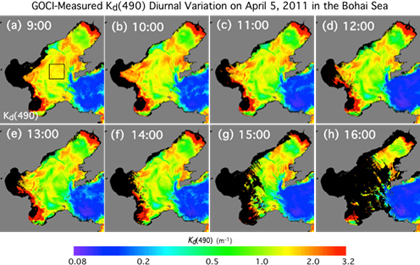
Maps of GOCI-derived diffuse attenuation coefficient at 490 nm (Kd(490)) in the Bohai Sea region on April 5, 2011 at the local times of (a) 9:00, (b) 10:00, (c) 11:00, (d) 12:00, (e) 13:00, (f) 14:00, (g) 15:00, and (h) 16:00. Significant diurnal variations of Kd(490) are observed in the central Bohai Sea between local times of 9:00 and 15:00. From 9:00 to 13:00, Kd(490) trended lower in the central Bohai Sea region and then increased slightly from 13:00 to 15:00.
|
|
Material for possible inclusion in the IOCCG Newsletter should be submitted to the Project Scientist, Dr. Venetia Stuart
Subscription to the IOCCG Mailing List. Participants receive a brief summary of the IOCCG Newsletter by e-mail (quarterly), as well as hard copies of IOCCG Reports as, and when, they become available.
|
|
|
|